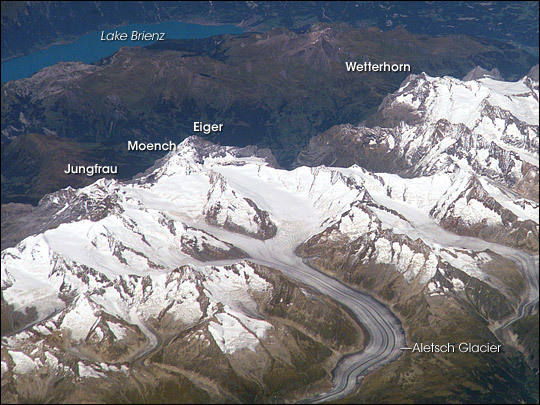An Astronaut's View of the Alps

The Bernese Alps are the portion of the great European mountain range located in southern Switzerland near the canton of Bern.
An astronaut took this picture by looking north-northwest while the International Space Station was over the Mediterranean Sea between Corsica and Italy. The oblique angle of the image, a hallmark of astronaut photographs , shows off the rugged glacial landscape.
Three of the higher peaks of the central Alps are visible: Jungfrau at 13,642 feet (4,158 meters); Moench at 13,415 feet (4,089 me); and Eiger at 13,025 feet (3,970 m). By comparison, Mt. Everest, the world's highest mountain, measures 29,035 feet (8,850 m).
To the east and south of the Jungfrau is the Aletsch Glacier, clearly marked by dark medial moraines extending along the glacier's length parallel to the valley axis. The medial moraines are formed from rock and soil debris collected along the sides of three mountain glaciers located near the Jungfrau and Moench peaks. As these flowing ice masses merge to form the Aletsch Glacier, the debris accumulates in the middle of the glacier and is carried along the flow direction.
Lake Brienz to the northwest results from the actions of both glacial ice and the flowing waters of the Aare and Lütschine rivers.
This article was provided by OurAmazingPlanet, a sister site of SPACE.com.
Breaking space news, the latest updates on rocket launches, skywatching events and more!
For the science geek in everyone, Live Science breaks down the stories behind the most interesting news and photos on the Internet, while also digging up fascinating discoveries that hit on a broad range of fields, from dinosaurs and archaeology to wacky physics and astronomy to health and human behavior. If you want to learn something interesting every day, Live Science is the place for you.

